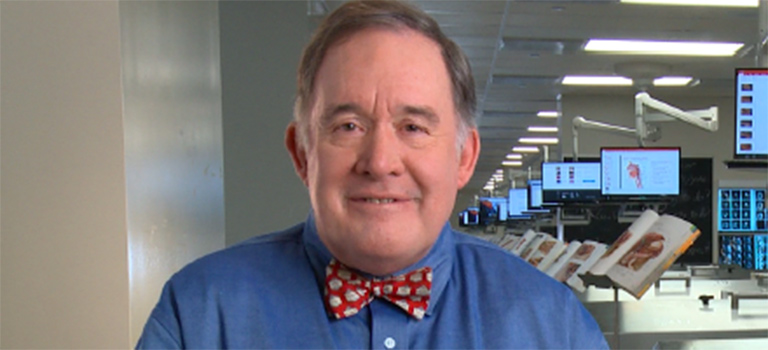Behind the Bow Tie: An Interview with Dr. William Stewart

Dr. William “Bill” Stewart, PhD, has taught at the Yale School of Medicine for more than 30 years. Since arriving on campus as a graduate student, Dr. Stewart has established himself as one of the University’s most collaborative scholars and a dedicated educator who is deeply invested in the growth of his students. He currently serves as an Associate Professor of Surgery (Gross Anatomy) on campus. We recently spoke with Dr. Stewart about his time at Yale and his trademark bow tie.
What drew you to anatomy as a field of study? Which areas of research are of particular interest to you?
I spent my grammar school years in British Columbia in Canada. I lived on Vancouver Island, where I definitely had the sense that I was separated from the mainland. Living “closer to nature,” I became interested in what made animals work. When I opened up a fish, I saw all kinds of interesting organs, and I wondered what they did. I remember as a child briefly trapping an octopus. It managed to escape and I thought, “That octopus seemed pretty smart. How did that happen?”
My father was a physician, so anatomical conversation became the norm. In high school, I developed an interest in teaching, so I joined the tutoring club. Yes, my school had such a club. I tutored math and French. In college, I took a brain and behavior course, and became very interested in the subject. I started, actually, a graduate career in experimental psychology. The deeper I got into experimental psychology, the more and more I became interested in the brain itself and less so in the behavior it produced. I transferred to a PhD program in anatomy.
I did my dissertation on the organization of the olfactory system—also known as the sense of smell. At that point, one of the pre-eminent olfactory nerve biologists was at Yale, and I came as his fellow for a few years. I actually expected just to be here for two years. And then, when it came time to think about what I would do after my fellowship ended, an anatomy position appeared at Yale, and I thought, “You know, I can do that.”
What have you enjoyed most about teaching and studying at Yale?
There are two threads. I have had parallel pathways in research and teaching. The thing that I found most compelling about research was that we were able to collaborate across departmental lines. We would be in a research group and, at that point, we were looking at aberrations in the brain, and there might be seven or eight people, all of them from different departments, all with a different expertise, all looking at some little piece of the puzzle.
The other strand is teaching. I’ve always enjoyed teaching. I find it fascinating to try and get people to understand things. At Yale, one of the things I enjoy tremendously is that I’m able, in separate courses, to teach the medical students, PAs, graduate nurses, and hospital paramedics. I’m very interested in tailoring my presentation to the audience, realizing that they have different needs and different strengths. Related to that, of course, is actually being able to stand next to them and get to know them as people. At this stage in my career, that is probably the most rewarding thing.
The Yale PA Online curriculum prioritizes an organ-based approach to teaching. What does that mean and how does anatomy inform the curriculum? How does it prepare students for a careers as physician assistants?
I have spent most of my teaching career trying to figure out what students need to know. This has meant trying to remove things from my lectures that interest me but are of little relevance to the student. The labs begin with clinical cases, where the symptoms have an anatomic basis. The lab itself tries to solve the problem by exploiting the anatomy. The cases were developed with our clinical colleagues. The course tries to develop and reinforces the knowledge and skills they will use as PAs.
The PA career provides a unique opportunity to combine a love of science and the ability to impact the quality of life for countless patients. The degree program is short and gets the PA to work right away.
Can you tell us a bit more about your teaching philosophy?
I’m a big believer in self-assessment, non-graded testing. I prepare quizzes that students can take as many times as they want. From my point of view, the ideal test is one where the class is clustered around 90 rather than the bell curve.
Why are PAs such crucial players in the health care system? How do you see their role evolving?
The old story is that the country doesn’t need more doctors; it needs the doctors to be distributed properly. There are physician shortages all over the country in rural areas, and I think that’s an obvious place for PAs to step in. Forecasts show a shortage of physicians far into the future. That shortfall must be managed by an increase in the number of PAs. I expect that they will practice semi-independently more frequently in the future.
What else should we know about you?
I like to bake and cook and eat. I like bread—I’ve got a sourdough culture that I’ve had for a while. I’ve got a fancy way of cooking the crust by putting stones in the bottom of the pan in the oven and I use a squirt gun to water them down when the bread goes in. It’s pretty hysterical, actually.
I also like to grill—I have a big Weber grill and a smoker. Every year, to support the Yale School of Medicine Hunger and Homelessness Auction, I offer, besides my bow tie, a beef and beer dinner at my house.

